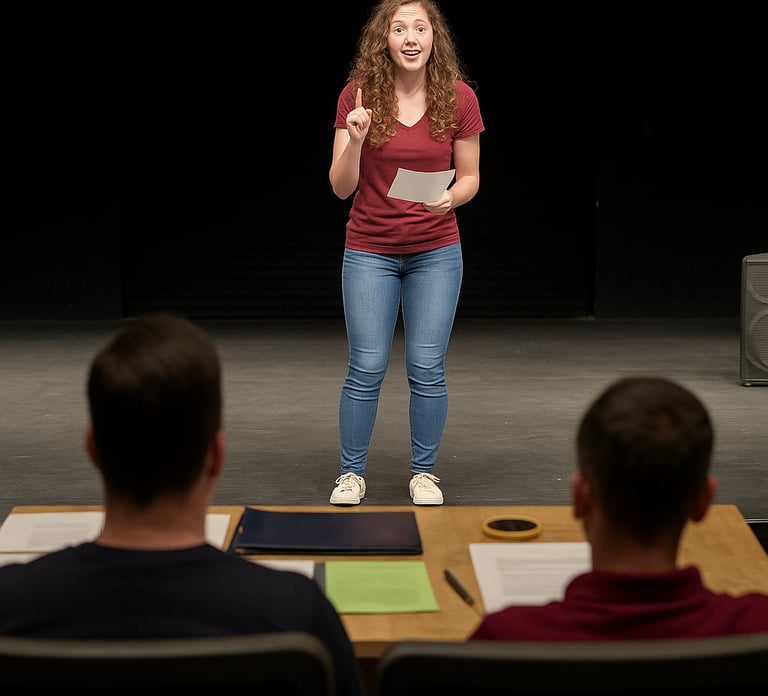School Theater Auditions: How I Approach the Casting Process (and Survive It Emotionally)
Learn how to hold auditions with confidence as a play director. Explore key casting factors, get tips for managing auditions transparently, and access free editable resources to enhance your audition process.
DRAMA TEACHER RESOURCES
Katie Zakkak
7/1/20254 min read


I both love and hate the casting process.
When I became a theater director, I found casting to be one of the most exciting creative decisions I could make. After weeks (or months!) of studying the script, dreaming up your vision, and imagining how it all might look, casting feels like unlocking the show.
But casting is also really hard—especially when you know someone’s heart is going to break.
Over the years, I’ve learned the best way to navigate the casting process is to be transparent and communicative with students. Let them peek behind the curtain. Help them understand the real factors that go into casting decisions.
If you want a head start on that, I offer a free editable Audition Tips Flyer—it’s Canva-based and fully customizable. Grab it here, or sign up for my newsletter to get it sent to your inbox.
The Four Core Factors I Use in Casting
1. Role Fit
This is the biggest consideration, and it has two parts:
Requirements for the role: This includes vocal range and style (for musicals), dance ability, and any technical skill the role demands. For example, if a role requires strong tap skills or the ability to belt high notes, I have to cast accordingly.
Character and chemistry fit: This part is harder to define. It’s about stage presence, emotional connection, chemistry with scene partners, and how well the actor embodies the director’s concept of the role. Sometimes it just comes down to who feels right in the part.
I explain to students that casting is like putting together a giant puzzle. It’s not about who’s “good enough.” It’s about finding the combination of people who fit this story, this vision, this time.
2. Rehearsal Availability
This is the practical side of things. I make it clear from the beginning that a student’s schedule and conflicts absolutely impact casting decisions.
A lead role requires time. If an actor is juggling multiple major conflicts—whether it’s sports, jobs, or other activities—they may be unable to commit to a lead's rehearsal demands.
That doesn’t mean they won’t be cast, but it does affect what roles are feasible.
3. Physicality and Stage Picture
This is always a sensitive topic, and I treat it with care—especially in educational theater.
Most of the time, I don’t let appearance be a major factor. However, occasionally, height or physical contrast might come into play if it directly affects the believability of relationships between characters.
Example: Mrs. Potts and Chip in Beauty and the Beast. Even though Chip is mostly in a cart, they appear together as humans at the end. If Chip is 5'10" and Mrs. Potts is 5'0", I might need to consider how that plays on stage.
That said, this is always a secondary factor, and I recommend directors reflect on their own values and vision before deciding how much it matters.
4. Seniority (All Things Being Equal)
This one’s a little controversial, so let me explain how I handle it.
Seniority is never my primary factor. But I do tell students that, if everything else is truly equal, and I’m deciding between a sophomore and a senior, I may lean toward the senior.
Why? Because they’ve had fewer years in the program and fewer opportunities left. The younger student has more time to grow and shine in the future.
Still, juniors and seniors have often been cast in the lead roles in my program. I believe this is because they have spent years learning and growing during their time doing classes and shows. It can be helpful to remind students of this when they seem to think it's solely due to seniority.
If you decide not to consider seniority, that’s totally valid—just be sure to communicate that clearly, especially to parents who might assume it is a factor.
Tips for Managing the Actual Casting Process
Have a casting panel. At least one other adult—musical director, choreographer, or trusted colleague—should weigh in. This helps protect you, supports transparency, and gives students more feedback if needed.
Use a clear audition rubric. You’ll thank yourself later. It keeps your notes consistent, helps justify decisions, and gives structure to an emotional process. Check out my audition rubric templates on TPT here.
Know what you're looking for before auditions start. Create a character breakdown and a list of must-haves for each role. It helps keep your vision centered while watching auditions.
Acknowledging the Emotion
Casting is a creative puzzle—but it’s also a human one. You will disappoint someone. You might even disappoint someone you really care about. That part never gets easier.
But when you explain your process, stay honest, and support students through both the joy and disappointment, you’re not just casting a show—you’re teaching life lessons that will stay with them forever.
Want Ready-to-Use Audition Resources?
My Audition & Rehearsal Resource Bundle on TPT includes:
Editable audition forms
Audition rubrics
Canva flyer templates
And more to help your process run smoothly and fairly
And don’t forget to join my newsletter to receive my FREE Drama Teacher Toolkit!
Final Thoughts
Casting is equal parts thrilling and heart-wrenching. The more transparent and structured your process is, the easier it is to stand by your decisions, support your students, and keep the focus on building a powerful, collaborative production.
You’ve got this. Happy casting—and break a leg!

